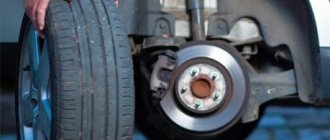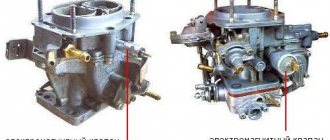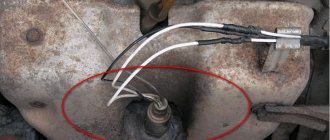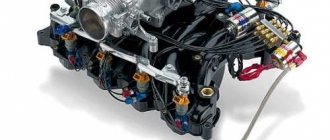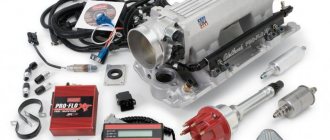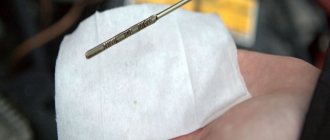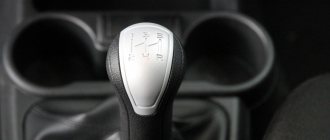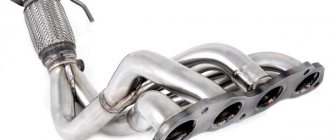As a rule, during the long-term operation of a vehicle, almost every driver sooner or later notices that the engine does not pull well. In other words, the power unit has difficulty coping with the loads, a loss is noted, the unit needs to be spun up to high speeds to maintain the usual pace, the car accelerates worse from a standstill, picks up speed slowly, etc.
At the same time, in many cases the motor runs smoothly, without shaking, knocking or noise during operation. Let us note right away that there is a fairly wide list of possible reasons why a warm engine does not run, and there is a loss of engine power when cold and/or when hot.
In this article we will talk about why the engine does not pull, and also consider the most common malfunctions that manifest themselves in the form of loss of traction of the power unit.
Read in this article
The engine does not pull: the main reasons for the decrease in engine power
So, if no other symptoms other than loss of traction are detected, then you immediately need to pay attention to the quality of the fuel, the proper functioning of the system, etc.
- As practice shows, more than half of the cases of reduced efficiency from internal combustion engines are associated with fuel. The engine does not turn on due to the fact that the tank may be filled with low-quality or unsuitable fuel for this type of engine (for example, 92-grade gasoline instead of 95-grade gasoline).
In some cases, after refueling, problems may also arise with starting the engine, and the engine appears. To solve this problem, it is often enough to dilute the existing fuel with a higher quality one. Less often, it becomes necessary to completely drain the fuel from the tank, after which additional flushing of the power system is performed.
Typically, such manipulations are necessary when, parallel to the loss of traction, unstable operation of the internal combustion engine is noted, and under load, the engine is difficult to start, on the panel, etc.
Also, owners of gasoline engines can independently determine the quality of gasoline. To check the spark plugs you need to unscrew them from the engine. A disruption in the combustion process of the fuel-air mixture in the cylinders, as well as the presence of impurities in the fuel, can be identified by soot on the spark plugs and its color.
For example, if the fuel contains a lot of third-party metal-containing additives and additives, then the skirt and electrodes may become covered with reddish soot (brick-colored). Black soot will indicate that the fuel is not burning properly, etc. In any case, malfunctions in the combustion process of the working mixture lead to the fact that the engine stops pulling.
- The next step in diagnosis is. A decrease in the efficiency of these elements is also accompanied by a decrease in the power of the power unit.
This is especially noticeable during sharp accelerations, and when the car is already moving at high speed. In other words, the motor has no “reserve” left for further acceleration.
The candles may be dirty, and it is also possible that their life has come to an end. To fix this problem, you can produce or immediately replace the entire set with a new one.
It is important to take into account that if new spark plugs are correctly selected for a specific engine in terms of heat rating and other parameters, but still quickly become dirty, then the reason for the loss of traction is not in them. The formation of carbon deposits in this case indicates problems with mixture formation or combustion of the fuel charge in the cylinders.
- If everything is in order with the spark plugs, then you need to check the condition of the fuel and air filters. In the first case, insufficient throughput can lead to the fact that the required amount of fuel is not supplied to the cylinders to prepare the so-called “power” mixture.
As a result, the engine loses power, that is, it does not pull under load. In such a situation, it is enough to replace the specified filter element. As for the air filter, the problem is similar to the fuel filter, but in this case there is a lack of air in the fuel-air mixture.
This leads to the fact that fuel without a sufficient amount of oxygen burns incompletely. In such conditions, engine power naturally drops, carbon deposits form in the combustion chamber, spark plugs become increasingly dirty, etc. To solve the problem it also needs to be replaced.
The injection engine does not pull
Why does the car not pull if the injection systems are equipped with feedback and can self-regulate in a “closed loop”? Unfortunately, the possibilities for self-regulation are not as wide as we would like.
The first enemy of injection systems is insufficient fuel pressure. When fuel consumption is minimal, the correction margin is sufficient for idling. But as soon as you put a load on the engine, the correction will jump to the maximum threshold, but the injectors will still be “underfilled”.
The pressure in the fuel rail is set by three components: the fuel pump itself, the pressure regulator and a set of filters (coarse and fine). The performance of a working fuel pump is several times greater than the engine needs at maximum flow rate - this is done so that pump wear affects the engine’s operation as little as possible. That’s why a fuel pressure regulator is used, which dumps “excess” fuel either immediately at the pump outlet or from the fuel rail after the fine filter.
In the first case, the fuel rail is called drainless (16-valve VAZ engines, modern foreign cars), in the second - drain. The difference between these systems is the location of the regulator and its operation. On drain ramps, pressure regulators are controlled by the vacuum in the intake manifold; the pressure in the ramp changes depending on the load (at 3 bar, normal for a VAZ, at idle it is 2.3-2.4 bar, take this into account when diagnosing!). On drainless ones, the pressure is maintained constant relative to the atmosphere and is 3.5-4 bar, depending on the car model. An exception is direct injection systems, where the operating pressure ranges from 20 to 70 bar.
Something else useful for you:
The resistance of fuel filters has no effect when measuring fuel pressure “in the plug” (the pump is forcibly turned on with the engine off, when there is no fuel flow in the ramp) and minimally at idle. But under load, an excessive increase in filter resistance reduces the fuel supply to the rail, which will lead to a loss of speed. Therefore, measure the pressure at idle and under load (for example, by hanging the drive axle and braking the wheels in gear). In cases where the idle speed is normal, and problems occur while driving, measuring the pressure only at idle speed (idle) is pointless.
Exception stages during verification:
- Remove the coarse filter (“mesh” at the inlet). This is a known problem for a number of cars - for example, on the second generation Focus.
- Replace the fine filter.
- Measure pressure under load.
- On engines with a drain ramp, clamp or otherwise plug the return line to eliminate the influence of the fuel pressure regulator. On engines with a drainless ramp, the RTD is installed in the fuel pump module; here it is easier to temporarily install a plug washer made of polyethylene or other material under it that is not destroyed by gasoline.
- Measure the pressure again: if it has increased, then the RTD needs to be replaced, otherwise the pump needs to be replaced.
The second reason for “underfilling” is clogged nozzles. Even with normal filter operation, the formation of deposits on the nozzles is inevitable over time. At home, you can only evaluate the shape of the spray pattern by removing the ramp and cranking the engine with the starter (Attention! This procedure is a fire hazard!). A clean nozzle should “dust” evenly, and not produce separate streams or pour to the side. You can evaluate the performance of injectors and compare it with the nominal one only on a bench.
Loss of dynamics is also a consequence of excessively enriched mixture. The fuel pressure regulator cannot be blamed here (the performance of the pump, even when operating without an RTD, is not so high that the correction margin of the injection computer does not cover the enrichment). It is much more likely that the injectors are leaking (again, checked on a bench) or the failure of the sensors that are used to calculate the injection time.
Here the undisputed leader is the mass air flow sensor - an accurate but sensitive device. As the air flow sensor gets dirty and ages, the readings become higher and the car begins to consume significantly more fuel. As a result, the over-enrichment of the mixture can no longer be corrected by the lambda probe. But such a malfunction is immediately visible: the car will begin to smoke, the spark plugs will be covered with black soot. On engines with an absolute pressure sensor, failure of the air temperature sensor is more likely (here it is a separate unit, while in the mass air flow sensor it is built-in).
On cars with an electronic throttle, it is worth checking the operation of the servo drive by removing the pipe from the throttle and allowing it to release gas. The throttle should open evenly, without pauses or wedging, indicating problems with the drive gearbox or critical contamination of the damper (the axle, overgrown with carbon deposits, becomes wedged in the housing).
Video: Lost power. Power Loss
An automobile power plant may not develop the required power, and the driver pays attention to this, as a rule, when the drop in dynamics is already obvious. You will hardly notice this if the car accelerates with great difficulty on a dry, hard and level road surface. What is the reason that engine power decreases, and what can be done in this case?
Malfunctions of the power supply system, ignition and impaired mixture formation
While problems with spark plugs and filters can be identified on the road, more serious problems associated with the power and ignition system are much more difficult to diagnose and fix on site. In cases where the engine does not pick up speed, and jerks and dips are noted when pressing the gas pedal, it is necessary to check the injector.
Let's focus on the more common electronic injection. The list of main malfunctions of modern injection internal combustion engines includes:
- malfunctions, decreased performance or contamination of the fuel pump mesh filter;
- malfunction of injection nozzles;
- problems with sensors or ECU;
- ignition system malfunctions;
- air leaks and leaking fuel lines;
If we talk about the ignition system, in addition to the spark plugs, you should also check the ignition coils, etc. As for the fuel supply, at the initial stage you should measure the pressure in the fuel rail (rail). At the same time, the pressure regulator in the fuel rail is also checked.
Often, on many cars, problems are associated with the fuel pump, which is located in the gas tank, as well as with the specified regulator. To measure fuel pressure, a pressure gauge is connected to the rail; the obtained values are compared with those recommended for a particular engine. If the pressure is below normal, then the culprit may be either the fuel pump or the pressure regulator.
The regulator's task is to discharge excess fuel into the return line at a time when the pressure is higher than normal. If the settings are incorrect or the regulator itself is leaking or faulty, then the fuel will be discharged into the return line ahead of time. To check this, air is pumped in with a compressor or pump, and the pressure in the rail increases. If the regulator operates earlier than the recommended pressure, the element must be adjusted or replaced.
Other reasons for reduced engine performance
The condition of the motor also greatly influences the power of the motor. The fact is that to protect the environment from harmful emissions during operation of the internal combustion engine, catalytic converters are installed in the exhaust.
During operation, the filter catalyst may be destroyed, reducing the throughput of the exhaust system. As a result, the engine is “strangled”. The check is carried out by measuring the pressure before and after the catalyst. You can also remove the element and inspect its condition visually.
As a rule, official services offer to replace a worn-out element, but the price of the spare part is very high. For this reason, on many cars in the CIS, the catalyst is simply knocked out, and the control unit is “deceived” by software or other available methods.
Also, when engine power decreases, it is necessary to check separately to eliminate the possibility of valve timing failure. Sometimes there are situations when the belt can jump one tooth, the chain stretches, etc.
In this case, the synchronous operation of the valve mechanism in relation to the operating cycles of the internal combustion engine may be disrupted. This leads to various failures, unstable operation of the unit and reduced power.
Let us also add that engine wear and certain malfunctions also affect engine power. As a rule, worn-out internal combustion engines with mileage usually lose about 10% of their declared power.
If the driver feels that the losses are greater, then the engine needs. Low compression in the cylinders can occur as a result of wear of the cylinder walls, piston rings, or incomplete closure, etc.
One way or another, any leaks in the combustion chamber will lead to expanding gases breaking out of the cylinder during fuel combustion. This means that the pressure of these gases on the piston will decrease, and the internal combustion engine itself will draw poorly and operate unstably.
Finally, we note that the reason that the car has lost dynamics may not be the engine, but the transmission. In other words, the power unit develops enough power, but it is not fully transmitted to the wheels.
This usually manifests itself in the way that the engine roars, the speed is high, but the car does not move or the acceleration is very slow in lower gears. Often such problems are associated with the clutch or slipping of the automatic transmission, as well as with jamming of the brake system. To check the brakes, just accelerate the car on a flat road, then put the gear in neutral.
If, when coasting, it is noticeable that the car immediately begins to slow down, then the problem is obvious, the wheels are slightly blocked. If no problems with the brakes are identified, then automatic transmission diagnostics are necessary. It is better to entrust this procedure to experienced specialists by delivering the car to a service center.
The new engine doesn't work. Causes of engine power loss
Carbon deposits on the engine valves lead to loss of sealing of the cylinder block and to a significant reduction in engine power and increased fuel consumption.
The valve springs must press the valve tightly against the seat; if this does not happen, the block will depressurize.
It is also quite possible that the fuel pump has stopped creating the required pressure. To do this, you need to remove it and check it. It is quite possible that the drive and its diaphragm will have to be changed. There is another very common malfunction - increased wear of the fuel pump rod.
An insufficient amount of fuel even leads to “starvation”. The ignition of the air-fuel mixture will be insufficient and the piston will move slowly. All this is achieved by correct carburetor tuning, precise selection of jets and many other factors. For the purity of the experiment, the current power of Mercedes-Benz was measured three times. Studies have shown that the V8 engine produces 442 hp. And this is 34 hp less than it initially developed - 476 hp. Quite a good result for such mileage and almost 15 years of age, isn’t it?
The solution is to clean the fuel pump filter, replace it (if repair is not possible) or install a new fuel pump.
As a rule, the reasons for an objective decrease in power are hidden directly in the engine systems: power supply, ignition, gas distribution, exhaust.
As for the increased wear of internal parts of the power unit, this reason quite often leads to a decrease in engine power. The first step is to inspect the piston group, since it is this unit that affects the engine power. If the piston rings are worn out, the compression will certainly drop, and, consequently, the engine power.
The compression has not changed much, but the engine is “eating oil”, engine oil consumption is much higher than normal, and the engine is smoking.
Stop driving with the handbrake, and traction will appear by itself
If you always set your car's handbrake but forget to release it while driving, prepare for compromised traction. When driving with the handbrake, you get the feeling that the car accelerates very slowly and it is too difficult to gain momentum. The driver immediately puts pressure on the engine, putting pressure on the suspension or gearbox. But he can’t even think that it’s enough to lower the handbrake lever for the problem to solve itself. Moreover, driving with the handbrake for quite a long time will cause the following troubles with the car:
These are the troubles that await you if you simply forget to remove the handbrake lever to its original position before moving off. If you have a manual transmission, keeping an eye on the handbrake becomes even more difficult. With an automatic, it is enough not to accelerate from the first second, but to let the car show its readiness for the trip, let it start idling. If you regularly leave the handbrake on, just stop using the handbrake. Leave it in gear, choose more or less level parking spots.
If the engine does not pull (loss of power, dips or jerks)
Clogged catalyst and exhaust system. To eliminate this cause of power loss, the catalyst must be replaced. But you need to take into account that its cost is quite high.
It is possible, and for this there are indicators of the highest speed and the period of time that the car spent covering 1 kilometer when accelerating from a standstill and vigorously changing gears.
If the time required to accelerate a car increases by more than 25 percent, and the optimal speed decreases by 15 percent or more, this is a clear sign. The drop in engine power is clearly felt when the car moves uphill.
All these malfunctions can be safely classified into one category, because they all have the same symptoms - the starter cranks the engine, but there is no smell of fuel from the exhaust pipe. If the car has a carburetor, then the reason must be sought in the float chamber. Most likely, fuel is not supplied to it.
We check the most common reasons for decreased cravings
Reduced engine power can also be caused by other problems. For example, if you independently re-equipped the main components and parts of the machine, you can be sure that the traction will decrease. It is also worth paying attention to the frequency of service and the quality of the purchased fuel. If you haven't changed the oil in your car for several years or tens of thousands of kilometers, the wear and tear on engine parts will be incredible. You will have to restore the unit, and loss of traction means that you have very little time left for repair and maintenance work. The main reasons for loss of traction are as follows:
- bad fuel - if the gasoline is terrible, it simply does not burn out completely and does not provide the required power;
- poor quality and poor frequency of engine maintenance, which caused wear of the main parts;
- increased wear of the piston group, poor engine efficiency and loss of power due to natural processes;
- depressurization of one of the cylinders, low compression due to large gaps between parts;
- failure of the electrical system, spark plugs, wires and sensors, failure of one or two cylinders;
- transition to alternative fuels, including gas, which naturally reduces the efficiency of the unit;
- installing wheels with a significantly larger diameter than were installed at the factory and replacing other important parts of the machine;
- performing engine overhauls using analog spare parts.
All of these processes cause a decrease in cravings, which is the main indicator that you need to do something quickly. Otherwise, you will have to look for how to sell a car that is not quite working and how to buy a more or less normal one with the proceeds. It’s better not to let this happen and at the first appearance of problems with traction, bring life back to your iron horse. A loss of engine power should be an indicator that action needs to be taken.
Tags: LPG, gas, repair, switches gas, replacing LPG filters
Comments 57
They installed it carelessly, of course, I think the valve will start to leak over time, the tube between it and the gearbox is too short. And also the filter, which, as you put it, is the main one, so-so, look for the original BRC model, it filters much better. I don’t understand why the installers took the money for the second time?))
successfully refueled, what can I say...
Yeah I got lucky =(
If you have copper pipe lines, the filter will always be clogged. I have a copper line on my loaf and the filter always gets clogged. On the Patriot the line is made of a black plastic tube, I don’t remember what it’s called correctly, and the filter is always in excellent condition, although I fill both cars at the same gas station.
Not long ago I encountered a similar problem. Replacing filters, trips to gas workers, mutual brain dumping. One of the masters hooked his laces and said let's go for a ride. It turned out that my coolant temperature is low! I twisted something and forgot for a while. A week later the same thing happened, and again the same reason. They didn't help. At home I started looking and noticed that the gearbox was connected first through the throttle heating, and then only the gearbox. I sent coolant from the thermostat to the gearbox and everything went away. So look at how it’s connected and sit down the master, let him look at it as he goes. It’s quite difficult to get to the stove hoses, so installers like to mess around.
I change this filter on a gazelle every 10 years)))
This dirt in the filter is rust from the tank.
it’s not a matter of gas but a new gas system, until the cylinder is washed so be it
Why is it better to solve the problem with traction at a service station?
Of course, if poor traction is due to a forgotten handbrake or bad fuel, no service will help you. Unless you need to eliminate the problem of increased wear of the brake discs. In other cases, it is better to immediately contact a service station and not experiment with independent repair options. This way you can restore your car in a short time, without having to check possible theories of failure. The main benefits of service in this case for professionals will be the following:
- specialists will find the cause of the problem and will be able to completely restore normal operation;
- the service will recommend that you change your driving habits so that you don’t end up in this situation in the future;
- The company will purchase all spare parts independently, which reduces the risk of purchasing low-quality parts;
- diagnostics will show the exact part that is worth restoring, which can often save you money;
- The repair will be carried out professionally, you will be given a guarantee for the serviceability of the repaired unit.
These are important advantages of servicing your car with specialists, so it is better not to neglect them and get maximum comfort in operating your car. You will often have to overpay for expensive professional services, but this overpayment will definitely pay for itself. After completing the repair at a good station, you will not have to worry about possible repeated problems with traction. However, the health of a car in most cases depends on the driver’s behavior and habits on the road. Therefore, if a certain problem constantly arises in your car, just change your driving style. If you have a domestic car, you can watch the following video describing possible problems when the car loses traction:
Let's sum it up
Given the rather complex design system of a modern car, the loss of traction may not be felt as much or even not felt at all in daily use. But this is a serious indicator that it is time to carry out a certain set of repair work. Therefore, it is better to listen to the car and try to determine its real problems. If a loss of power is noticed, it is best to immediately go to a service station and fix the problem. This is the only way you can avoid serious damage with quite costly consequences.
If your car has lost power for a long time, you shouldn’t think that this is a natural process of car aging. It is better to set a goal and eliminate all possible causes of this problem. However, loss of power can indeed be a natural process. Major repairs, replacement of original parts with analog ones and other familiar processes for the car owner are a real problem for the operation of the unit. Tell me, have you encountered a sudden loss of power in your car, and how was it decided to deal with this problem?
In general, the engine can stop pulling for a variety of reasons - this is one of the most common malfunctions, which can have a huge variety of reasons, and below we will look at the most likely ones, describe their symptoms and examine this issue in detail. After all, one day something can happen to each of us when the engine loses power, without being accompanied by any further symptoms. The engine probably isn't showing any obvious signs of any illness, it appears to be mostly fine and isn't making any unusual noises or vibrations, but it just doesn't pull as well as it usually does. And the problem seems to be getting worse and worse every day, although you probably didn’t even notice when the engine first started to pull worse.
If you are familiar with this situation, then let's look at the following reasons for the reduction in engine torque:
Poor quality fuel
First of all, you need to blame the fuel - remember where you last refueled - perhaps it’s a new gas station or one whose fuel you have not previously had experience driving with. It is quite possible that the fuel simply turned out to be of very poor quality (it happens that you will simply be lucky if your engine simply stops running - after all, someone’s engine will probably stop starting altogether until the owner completely replaces the fuel in the tank).
If you refuel at the gas station where you usually go, and nothing arouses suspicion, go to local communities on social networks, the car club of your region/district, or just a city portal - perhaps the gas station simply had a bad supply of fuel.
However, most often, coupled with loss of torque, the incompatibility of the engine with such low-quality fuel also has other symptoms - for example, instability of engine speed, difficulty starting and some others, depending on how bad the fuel turned out to be and on the car model.
But you can most likely determine the poor quality of gasoline yourself by unscrewing the spark plugs from the engine (for this you will need a special spark plug wrench) - in general, spark plugs can often be used as the primary diagnostic method for certain malfunctions in the combustion chamber of the engine, since they work together most closely with this combustion chamber and at the same time are quickly removable. If the fuel contains a large amount of metal-based additives, then the contacts of the spark plug and the “skirt” of the central diode will have a reddish coating (as if red brick had been crushed onto the spark plug).
Dirty air filter
You may also simply have your air filter dirty, and in this case, eliminating the loss of power will probably cost you less than all other options - just replace the air filter - you can either buy it yourself or replace it yourself.
The problem with a dirty air filter is that the fuel-air mixture that enters the combustion chamber of your engine's cylinders does not receive enough air, and therefore the fuel does not burn completely, because a sufficient amount of oxygen is needed for its combustion. The situation turns out to be similar to that of a person with a runny nose - he seems to be eating enough and leading a healthy lifestyle, but at certain moments in his life (during illness with this runny nose), clogged nasal passages do not allow him to breathe normally.
Dirty or old spark plugs
The spark plugs may well be fouled or excessively worn, in which case if the engine is not running because of them, it is also a relatively inexpensive option to fix the problem - simply clean the spark plugs or replace them. However, it should be borne in mind that both periodic contamination and wear of spark plugs is an abnormal process, and the reason for this most likely lies somewhere deeper, or in the spark plugs themselves.
Dirty fuel filter
The fuel filter, like the air filter, can cause a loss of engine power. And the physics of the process here is similar to the air filter - if in the case described above the fuel did not burn completely due to lack of air, then in the case of a dirty fuel filter, on the contrary, an insufficient amount of fuel is supplied. In this case it's simple.
Mechanical problems with the engine
If all of the above methods did not help, and the engine still pulls the car poorly, then it’s time to entrust the matter to professionals - stop by a good car service and diagnose the engine’s operation - checking the compression (compression ratio in the combustion chambers), for example, can say a lot about the operation engine, including information about approaching its service life limit and upcoming expensive repairs.
Fuel system malfunction
It is quite likely that the reason for the drop in engine torque is a violation of the normal operation of the fuel supply system to the cylinders, and there may also be a number of reasons why the engine does not gain speed, let’s list the main ones:
- Faulty (dirty) fuel pump due, for example, to low-quality fuel or gasoline being sucked out from the bottom of the tank, where most of the foreign dirt particles have settled.
- Malfunction of the injector or oxygen sensor.
- Leaks in fuel supply hoses or tubes where air is sucked in.
The catalytic converter or exhaust system is clogged
A contaminated catalytic converter or exhaust system line can also cause a decrease in engine torque. In both cases, replacing the corresponding contaminated component will help. It should be borne in mind that the catalyst, as a rule, is very expensive due to the content of noble metals in certain quantities.
We have listed the main and most probable reasons for a possible loss of engine power - you need to remember that there are a great many such reasons, and if you were unable to establish them yourself, then you must definitely go to a car service workshop to entrust this matter to professionals.
Modern engines have good power, a sufficient level of efficiency, and pollute the environment less. When the behavior of the power unit changes, it is immediately noticeable. If the car does not pull, the reasons for this phenomenon can be very different. Let's look at them.
An engine can lose traction for various reasons. There are a huge number of different faults that result in loss of power. Sometimes cravings go away without any symptoms. The unit does not make unusual noises, does not vibrate - it just has lost traction. Every day the car drives worse and worse. This situation is probably familiar to every motorist.
Causes of loss of engine power
Welcome, friends, to the DIY car repair website. A good car enthusiast knows the capabilities of his “horse” and its potential on the road. This is why any drop in engine power is immediately noticeable.
Causes of loss of engine power
Another thing is that determining the cause of this phenomenon is not so easy. In this article we will look at the problem from all sides and highlight the main reasons for the loss of engine power.
Check the air filter
A filter that is too dirty does not allow enough air to pass through to create a fuel mixture. This can lead to a significant drop and fuel consumption will increase significantly.
In addition, the quality of the materials used in it can also affect the operation of the motor.
When purchasing another filter, many try to buy the cheapest product available. You shouldn’t buy just anything, because further engine repairs will cost much more.
There are many different stories about cheap and unoriginal filters. These products break, and then a series of serious malfunctions follow the chain, including failure of the piston rings. To check the condition of the air filter, you need to open the hood, remove the element from the housing and visually assess the condition. If necessary, the part is changed immediately.
Power system pressure
The fuel pump is located in the gas tank on the injection engine. The pump will be found under the hood, on the engine. For most cars, power loss can be attributed specifically to the fuel pump.
Many modern cars have special connectors on the fuel line for connecting a pressure gauge. This way you can check the pressure. If the connector is missing, you will have to work a little to connect.
Pressure values can be found in the engine instructions. There is a special regulator in the line, with which you can relieve excess pressure directly into the tank. This regulator may be incorrectly configured, or it may leak. To check it you will need an ordinary air pump. Using it, you need to smoothly raise the pressure level to the one indicated in the passport for the motor. If you did not have time to increase the pressure, and the regulator dumped fuel into the tank, then it must be replaced.
Air flow and pressure sensor
These two elements determine how much air the engine consumes, as well as how much air is needed to create the optimal air-fuel mixture. If these sensors fail, then the ECU will not make the calculations correctly and, accordingly, traction may be lost. If the car does not pull, the reasons (including the VAZ-2110 injector) may be in these sensors. If necessary, they should be replaced, and then the power will return again.
But if the car has an ECU, why doesn’t the corresponding light on the dashboard light up? The electronic control unit is programmed for an open or short circuit. If there is none of this, and the sensor simply does not work as it should, the computer will be able to report that the mixture is being prepared incorrectly. If the car pulls poorly, there may be other reasons, but it’s worth checking the sensor. You will have to look for the source of the sensor’s malfunction yourself. The parameters of a specific element can be found in the instructions.
The engine does not develop power - causes, checking and troubleshooting
An important condition is to have a larger nozzle for air than a nozzle for gasoline. Then the carburetor float chamber is adjusted, which should only be half filled with gasoline. After this, the car engine starts and the quantity and quality of fuel is adjusted in accordance with the technical literature for this carburetor model.
If the DKPV sensor untimely sends a control command to supply the air-fuel mixture, then the power of the internal combustion engine decreases right before our eyes.
Probably, any driver has encountered such a problem when the car has lost its former dynamics: it takes a long time to accelerate, and when climbing, it completely refuses to move in higher gears. In this article we will tell you in detail what to do if the VAZ engine does not pull or pulls poorly, we will look at the main causes and troubleshooting methods.
There are situations when the DCPV untimely sends a control command to supply the air-fuel mixture. As a result, the power of the power unit drops before our eyes. The main cause of the failure is the shift of the toothed star relative to the pulley and the delamination of the damper. In such a situation, it is necessary to carefully inspect the damper and replace it.
Checking the exhaust system
The design of a modern engine is quite complex. Manufacturers make them so that cars do not pollute the environment. Or if they polluted it, it was minimal.
So, one of the devices that affects the purification of exhaust gases is a catalyst. It can be located in different places. If your car has it, then with regular use of low-quality fuel, which is sold in large quantities at most of our gas stations, the catalyst may become unusable. But it not only collapses, but can also block the normal exit of exhaust gases. As a result, the car does not pull uphill. Reasons include a clogged catalyst.
To check the catalyst, it is necessary to use remote thermometers. You can also check its performance by the pressure before and after the device. If all these possibilities are not available, then you will have to dismantle the device and assess its condition visually. If the catalyst is clogged, it should be replaced or a flame arrester installed instead.
Compression
If the car does not pull, the reasons may be compression. To check you will need a compression gauge. It is better if it is equipped with a pressure gauge with good accuracy. When operating the engine, the piston rings are ground off. As a result, compression in the cylinders decreases or disappears altogether. If the timing valves are not installed too tightly in their seats, then the test will show poor results.
To identify the cause of poor compression, after the measurement is completed, add oil to the cylinder and then measure again. If the level has increased slightly, then the piston rings need to be replaced. If you are unlucky and the compression remains the same, then the valves will need to be replaced. If the car does not pull, the reasons (VAZ-2109 is no exception) may be precisely this.
Before measuring compression, the battery should be well charged. Otherwise you will not get the correct indicators. A compression gauge is screwed in instead of spark plugs. This is much better than using a rubber seal. Perhaps, if the car does not pull, the reasons are low compression.
Reason 7. Automatic transmission with surprise
If the car does not pick up speed, and you press hard on the gas, the reason may be in the automatic transmission. At the same time, you can hear that the engine is roaring like a wounded bison, but the power does not reach the wheels. To check if the problem is really in the automatic transmission, do the following:
- Drive onto a flat road without turns. Set the handle to Drive.
- Drive a couple of kilometers, observing the behavior of the car. If when you press the gas, the speed decreases, the problem is in the braking system. If the car does not pull and you hear a loud sound from the engine, then you need to check the automatic transmission.
It will not be possible to close the list with 7 reasons, however, the remaining breakdowns can only be calculated by a master diagnostician. We wish your horse not to break!
I somehow installed an LPG...it’s a necessary and useful thing, oats are expensive these days...but before I could get enough of it, problems started about three months later. When I pressed the accelerator, the car started to stall and switched from gas to gasoline...that’s how it is. But there was nothing to do, I went to the installers. They . -how much did you drive? I am -2 thousand km. they - yeah, it's in the settings. I - look. we hooked up our laptop and for some reason they gasped for about 2 minutes...Everyone says they charge you 500 rubles. I pay, I go, I drive about 200 km again, I’m a dumbass, I call...they say, come and see...I arrived, they hooked up their barrel organ again, they revved up for 5 minutes...they say 200 rubles and I’m free...I cry and take it to load filter...I'm driving happy for 3 days...and...yes yes...stupid...I got upset with the cylinder and screwed it up and then decided to go to normal gas workers...but my hands were itching, I decided to change the filter and try what and how...and so...let's see...by the way, after replacing the filters My gas car now just rips like it’s running on nuclear fuel. thank you all for your attention...
Checking the transmission
Sometimes the power unit can develop serious power, but it does not reach the wheels. If while driving you hear that the engine is working hard, but you don’t feel speed, then perhaps the automatic transmission system is slipping or there are blockages on the brakes.
To check, you need to drive onto a straight section, set the automatic transmission selector to position D, and then see how the car behaves. If the speed decreases, then diagnostics should be carried out. If everything is in order with the brakes, you need to go to a good service station and check the automatic transmission.
You can also check the parking brake. To do this, you need to go to free space. Warm up the car and then pull the handbrake. Next, press the brake pedal and set it to position D. Next, press the accelerator. If the engine keeps the rpm around 2000, then everything is fine with it. If it is less or more, you should go to a service station to test the automatic transmission.
Why the car doesn't pull: reasons (carburetor)
If such an engine loses traction, the fuel pump fitting may be dirty or there may be low pressure in the system.
It is also possible that the carburetor is simply dirty or there is some problem with the needle valve. There may be errors or incorrect settings for adjusting the composition of the fuel mixture. If the carburetor flaps are not open enough, traction may be lost. When the fuel level in the engine decreases, traction also disappears. When there are any problems with traction in the engine, it is urgent to carry out a full diagnosis.
You definitely need to find out why the car pulls poorly; we have already looked at the reasons. If a malfunction is found, it should be corrected immediately. If you could not find the reason for the decrease in cravings on your own, there is no need to hesitate. A more in-depth examination should be carried out at the service station. But basically, the cause can still be identified and eliminated independently.
So, we found out why the car loses traction.
